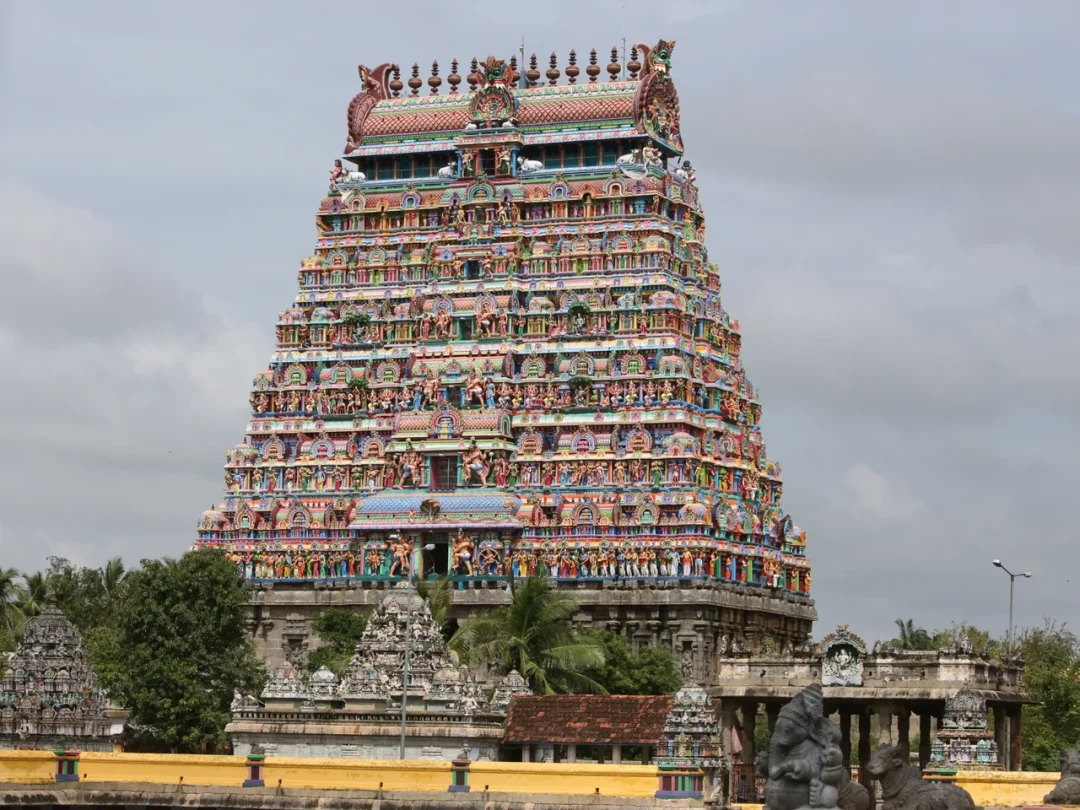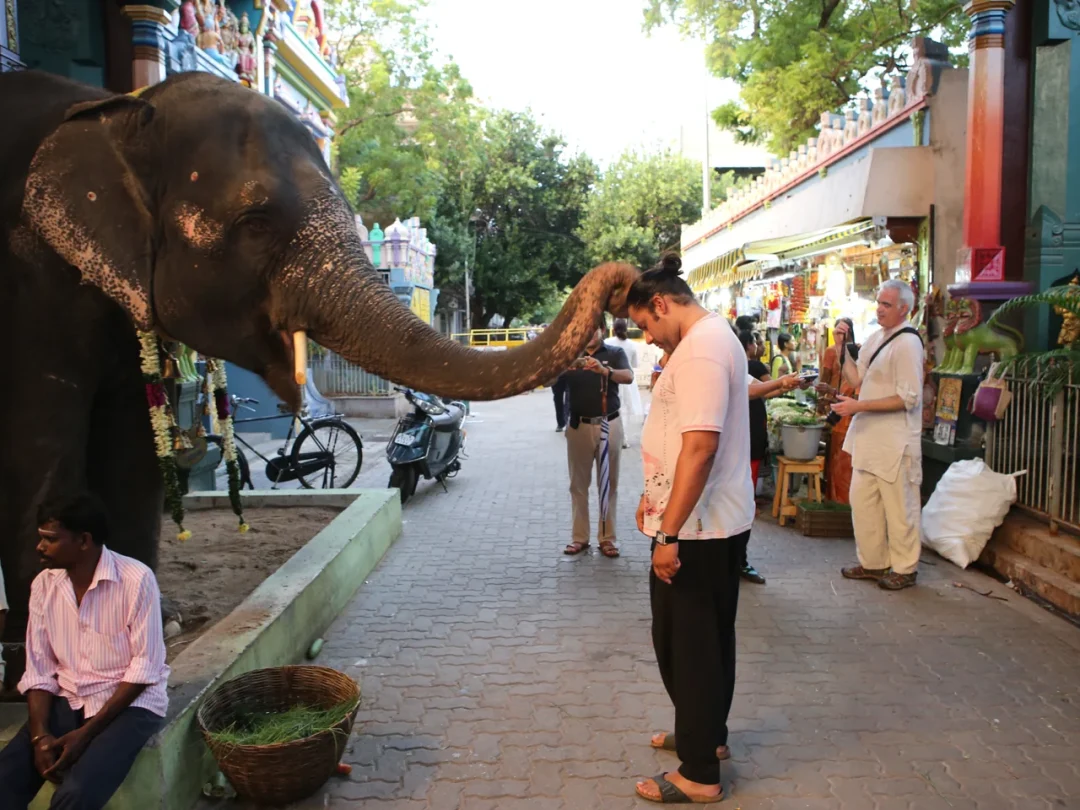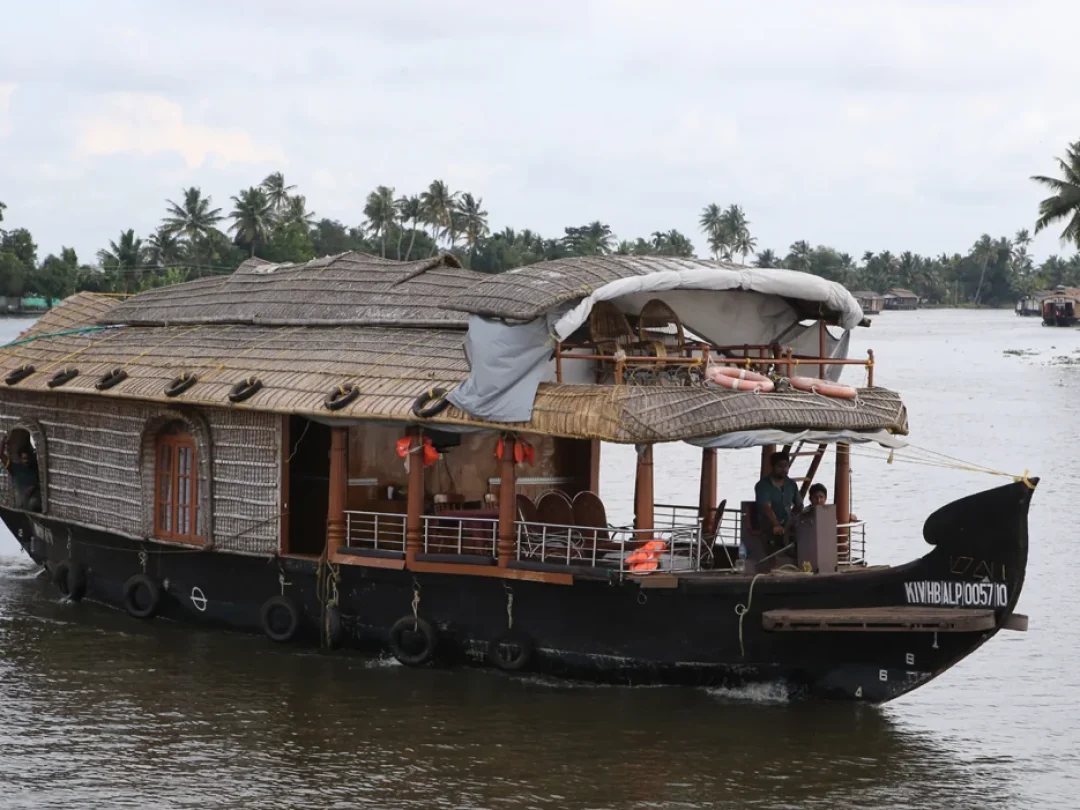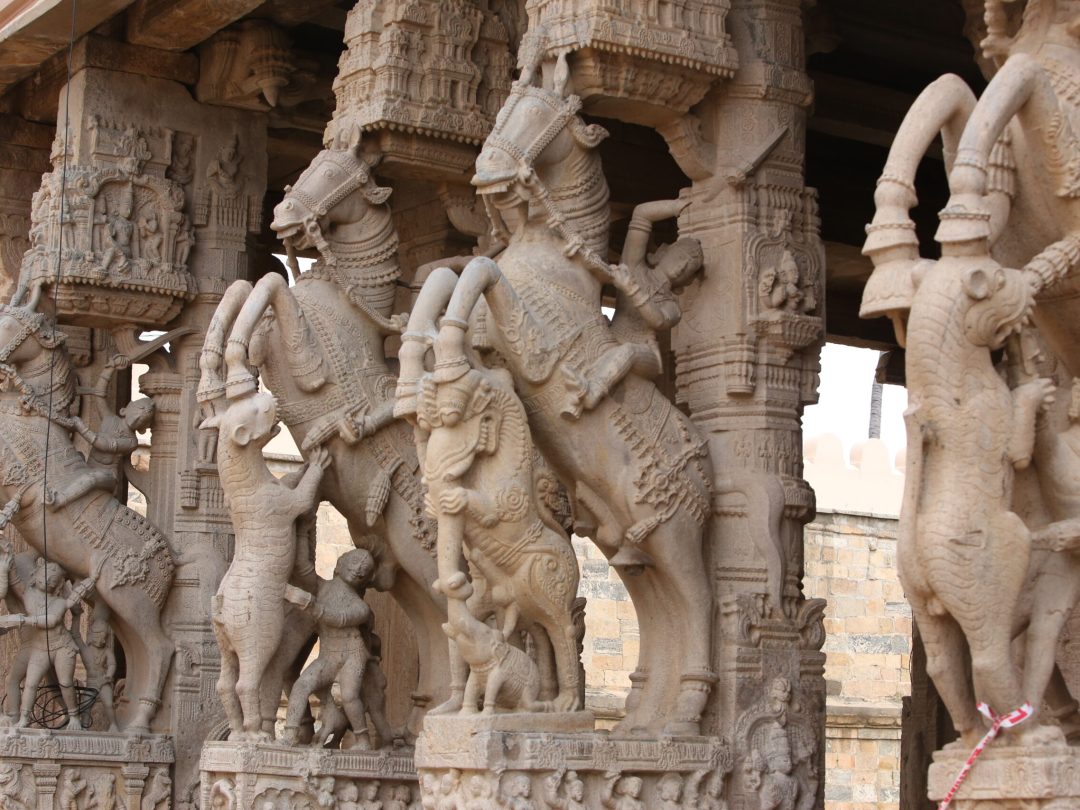Temples of South India
Chennai, Kanchipuram, Mahabalipuram, Pondicherry, Chidambaram, Kanyakumari, Thanjavur, Trichy, Madurai, Periyar, House Boats (Backwaters) and Cochin




Dates: Forthcoming (~14 nights)
- We will drive across India, from the East (Bay of Bengal) to the West (Arabian Sea), visiting breathtaking temples of ultimate grandeur – all that has made India famous.
- The tour will be led by Deepak Singh (President and Founder of Spiritual Journeys, LLC). We will have both Spanish and English speaking guides with us.
India’s recorded history goes back to 4,000 years, with remarkable examples of civilization well ahead of other countries. Throughout this period, reverence was shown to the many Gods her people worshipped, and the land was dominated by independent kingdoms. Reverence to the Gods led to gold and jewels and the finest of architecture bestowed onto them, and the independent kingdoms accumulated wealth not seen elsewhere. Thus she was a prime target for marauders, attracted by her wealth and attributes of her civilization. Forts for defense and palaces for residence were de-rigor for the independent kingdoms, and though many have not survived the ravages of time, those that have, were either too beautiful not to have been maintained or too well built and withstood the elements. Thus, there are some exquisite examples of architecture that we will not only see, but also live in – most perhaps only 200 to 400 years old, though some forts going back to at least 1,000 years.
Overview
Highlights:
- Culture and history of Kanchipuram
- French cultural amalgamation in Pondicherry. Aurobindo Ashram.
- Chola architecture and temples Chidambaram, Thanjavur, Madurai)
- Periyar Lake
- Kerala backwaters and Cochin
- Visit to Kanyakumari
Itinerary
Map of area (https://maps.app.goo.gl/D3wFZfjkG5AQpWhR8) shows where we will be going. Zoom in or out to change detail. Route shown is by road. We will be flying across longer distances.
Day 1: Depart the Americas
Depart this afternoon from the Americas for your journey from the Arabian Sea then across South India, from the Bay of Bengal on the East coast and back to the Arabian Sea on the West coast. Overnight: On board your aircraft.
Day 2: Arrive Chennai
Our representatives will meet you as you exit customs and immigration at Chennai airport, and transfer you to your hotel. Overnight: Chennai.
3 October: Chennai – Mahabalipuram
Spend the day sightseeing in Chennai then drive to Mahabalipuram (1 1/2 hrs). Overnight: Mahabalipuram.
More than a city, Chennai (or Madras as it was earlier known), is a potpourri of impressions: a fistful of colour, a whiff of jasmine, the rustling of silk. It brings to mind the subtle, intricate variations of classical music, the evocative grace of Bharatanatyam and spontaneity of bronzed Dravidian faces. Stray images chase one another: bold colour drawn into the pleats of the Kancheepuram sari; a neat, swaying, ebony plait crowned with a spray of flowers; complicated and exuberant sculpture lacing temple walls. The gateway to the south and the capital of the state of Tamil Nadu, Madras or Chennai is a vibrant metropolis and a combination of old world charm and modern day efficiency.
Visit San Thome Basilica, a Roman Catholic minor basilica in Santhome. Built in the 16th century over the tomb of Saint Thomas, one of the twelve apostles of Jesus. It was rebuilt as a church with the status of a cathedral by the British in 1893. This church is one of three churches in the world built over the tomb of an apostle of Jesus. The other two being St. Peter’s Basilica in Vatican City and Santiago de Compostela Cathedral in Galicia, Spain. Also visit St. Mary`s Church the oldest surviving Anglican church in India
Day 3: Mahabalipuram
Spend the day sightseeing in Mahabalipuram. Overnight: Mahabalipuram.
Kanchipuram is the ancient capital of the Pallavas famous as a city of 10 Temples and still has 124 shrines. The first temple dedicated to Shiva was built in the 7th and 8th century and has paintings on the walls. Temples of Ekambaswara, Kailasanatha, Sri Kamakshi and Varadarajaswamy are of interest. Kanchipuram is also famous for its silks. Later visit the magnificent rock temples and carvings in the beach town of Mahabalipuram. Five Rathas (chariots), ceremonial chariots, rock-cut monoliths, named after the 5 Pandavas. The Shore Temple by the sea surrounded by gardens designed according to descriptions of the original layout from ancient times. Built in sandstone in the 7th century. Bhagiratha’s Penance is a bas-relief (27cm to 9m) sculptured on the face of two enormous adjacent rocks, depicts, the penance of Arjuna, myriad characters from the Mahabharata, realistic life-size figures of animals, gods and saints watching the descent of the river goddess Ganga to earth.
NOTE:
• Most temples in South India are open 6.00 AM to 11.00 AM, then 4.00 PM to 6.30 PM (being closed from 11.00 AM to 4.00 PM).
• Non-Hindus are not allowed inside the sanctum sanctorum.
• Photography is strictly prohibited in the temples.
• Dress code must be adhered.
Day 4: Mahabalipuram – Pondicherry
After a leisurely breakfast, drive to Pondicherry (2 1/2 hrs). Overnight: Pondicherry.
Pondicherry was a French settlement that comprised Pondicherry (locally called Pondy), Yanam, Karaikal and Mahe. There is a strong influence of French culture in Pondy, especially on its architecture, a result of the centuries-old relations this place maintained with France.
Sri Aurobindo Ashram. The ashram was founded in 1920 when Sri Aurobindo reached Pondicherry, a French colony and put in place his ideas of peaceful community. The ashram was run by his French companion Mirra Alfassa, known as the Mother. The ashram houses the samadhi of Sri Aurobindo and the mother and is open to the public.
Pondicherry Museum has a very good sculpture gallery and a section of archaeological finds from the Roman settlement at Arikamedu. There is also a French section charting the history of the colony. The objects include the four-poster bed in which Dupleix is believed to have slept. There is also a superb collection of the snail shells from the Pondicherry Region.
Church of the Sacred Heart of Jesus. Built in the Gothic style, this massive church is one of the most beautiful churches in Pondicherry.
Day 5: Pondicherry
Spend a relaxed day of sightseeing in Pondicherry. Overnight: Pondicherry.
Day 6: Pondicherry – Chidambaram – Thanjavur
Drive to Tanjore visiting Chidambaram enroute (1 1/2 hrs then 3 hrs). Overnight: Tanjore.
The small town of Chidambaram is built around a great temple-complex is a highlight of Dravidian architecture and was built by the Cholas from 907 to 1310 AD. It has four large Gopurams with finely sculptured icons depicting Hindu myths. Probably the greatest Chola emperors were Raja Raja Chola, who held the throne from 985 to 1016, built the greatest of the empire’s 74 temples, the Brahadeeswarar, with its soaring tower over the inner sanctum rising more than 62 meters (200 feet) with a single block of granite weighing 80 tons on its dome, and his son Rajendra-I whose navy competed with the Arabs for controls of the Indian Ocean trade routes and who was responsible for bringing Srivijaya under Chola control.
Day 7: Thanjavur – Madurai
Depart for Trichy (1 hr). Onto Madurai (2 1/2 hrs). Overnight: Madurai.
Thanjavur was the ancient capital of the Chola kings whose origins, go back to the beginning of the Christian era. Power struggles between these groups were a constant feature of their early history, with one or other gaining the ascendancy at various times. The Cholas’ turn for empire building came between 850 and 1270 AD and, at the height of their power. Probably the greatest Chola emperors were Raja Raja Chola, who held the throne from 985 to 1016, built the greatest of the empire’s 74 temples, the Brahadeeswarar, with its soaring tower over the inner sanctum rising more than 62 meters (200 feet) with a single block of granite weighing 80 tons on its dome, and his son Rajendra-I whose navy competed with the Arabs for controls of the Indian Ocean trade routes and who was responsible for bringing Srivijaya under Chola control.
Tiruchirappalli (Trichy) is situated in center Tamil Nadu, was built by the Nayak rulers of Madurai around a rock fort, on the banks of the Kaveri (also Cauvery) river. It was a Chola citadel during the Sangam Age and was also briefly ruled by the Pallavas and the Pandyas. Today, Trichy is a blend of history, a pilgrim center and a thriving commercial city.
Trichy was and is famous for the Ranganatha Temple at Srirangam, 10 km away. The Rock Fort is the center of the city and is a remarkable 83 meter high structure dominating the landscape. The Uchi Pillaiyer Temple dedicated to lord Vinayaka or Ganesha has 344 steps, cut into the rock leading to the temple with the Tyaumanaswami Temple of lord Shiva half way up the hillock. Cave temples in the fort with sculptures date back to the 6th and 7th centuries. The Sri Jambukeswara Temple, at Tiruvankkaikaval, Srirangam is an island in the Kaveri river, north of Tiruchirapalli. The Ranganathaswami Temple here, built around 13th-14th centuries has 21 towers and stone pillars covered with fine carvings.
Situated on the banks of river Vaigai, Madurai is more than 2,500 years old and has a rich cultural heritage and history, and even as early as 550 AD, it was an important cultural and commercial centre. Madurai was the capital city for the great Pandya kings.
Visit the Meenakshi Temple & Tirrumalai Nayak Palace and Thirumohur (10 km). This place has its legendary origin in the distant past when Devas (Gods) and Asuras (Demons) churned the ocean to get Amritham (nectar). In the evening visit the Meenakshi temple to attend ceremony every evening where the marriage of Meenakshi (Parvati) and Sundareshwara (Lord Shiva) is solemnized. If time and interest permits, spend time sightseeing Madurai,
Day 8: Madurai
Relaxed day of sightseeing in Madurai. Overnight: Madurai.
Visit the Thirumalai Nayak Palace built in the 16th century, highlight being its most attractive grand pillars. The palace, built in 1636 by King Thirumalai Nayak, was considered an architectural marvel during its construction. It has a fusion of Dravidian and Islamic styles of architecture. Also visit the Meenakshi Temple dedicated to Goddess Parvati and a thousand pillared hall with eye-catching sculptures. The complex is adorned with many shrines and architecture.
Day 9: Madurai – Periyar
After breakfast, depart by road for Alleppey, stopping for the night at Periyar (3 1/2 hrs). Overnight: Periyar.
At Periyar, go for a boat ride on Periyar Lake. A wonderful scenic and serene experience after the hectice road journeys.
Day 10: Periyar
Spend the day lazing in this tranquil property. Experience a short demostration of the Kerala Martial Arts, Kalaripayattu. In the evening, participate in a cooking class at your hotel.Overnight: Periyar.
Day 11: Periyar – Alleppey
Depart early for Alleppey (2 1/2 hrs). Upon arrival, board your house boat and spend rest of day in the backwaters of Kerala. See inner India, schools, places of worship, paddy fields, local village life all on the banks of the water as you slowly chug through. Overnight: On-board your houseboat.
Please Note for the Houseboat:-
• Check in at 12.15 hours and Check out at Pallathurathy /Alleppey by 09.00 hours.
• Standard Cruise starts from 12:00 Noon to 18:00 hrs and again from 06:30 to 09:00 hrs next day
• Between 18:00 hrs to 06:00 AM , the Houseboat will be anchored in safe place for dinner and overnight sleep.
• Air-condition in rooms will be operated during the sleeping hour’s only i.e. from 21.00 hours to 06.00 hours
• It will be full board package and menu will be “Kerala cuisine“
Day 12: Alleppey – Cochin
After breakfast on board, disembark and drive to Cochin (1 1/2 hrs). In Cochin, spend the day sightseeing this historic city. Overnight: Cochin.
It is believed that spices originated from Cochin were presented to King Solomon by the Queen of Sheba. In 1000 BC Phoenicians, trading with Cochin, supplied the Pharaohs of Egypt with aromatic oils and spices which were used to preserve the embalmed bodies of the Egyptian Kings and Queens. After Rome conquered Egypt, the Roman galleys were carrying goods to imperial Rome where pepper, the most prized import, was worth its weight in gold.
St. Thomas arrived in the first century AD. The Jews arriving here in the wake of the Diaspora were given sanctuary and titles of land and established a flourishing trading community in Cochin. For the next thousand years the spice trade was controlled by the Arabs who supplied these exotic wares through the Italian City State of Venice. Marco Polo in his travelogue writes about a flourishing trade between Cochin and China when he visited these parts. In order to break the Venetian stranglehold on this lucrative trade, the Catholic Majesties of Spain and Portugal financed independent explorations to discover a direct sea route to Cochin. Christopher Columbus under the patronage of King Ferdinand and Queen Isabella of Spain began his journey by sea to Cochin; but eventually discovered the continent of the Americas. Vasco da Gama, the Portuguese explorer (1498) directly established, for the first time, a sea route between western Europe and the Orient. The Dutch in their quest for colonial expansion fought the Portuguese in a major sea battle in the Harbor of Cochin and established a Dutch trading port. In the 18th century, Cochin came under the British rule and became an integral part of their empire. Being naturally blessed with an all weather harbor it soon became the premier port and commercial hub of South India.
Visit the Mattancherry Dutch Palace, built by the Portuguese in 1555 and renovated by the Dutch in 1663. In the ancient rooms are 17th century murals that relate in vibrant color the story of the epic Ramayana. See streets of picture-postcard houses out of another age, in 17th century Dutch and traditional Kerala styles. Visit St. Francis Church, the oldest European Church in India. It has several antiquities including a wealth of records. These include a palm-leaf title deed the local Raja gave the Portuguese in 1503. See the Chinese Fishing Nets, unique to this part of Kerala and living symbols of a centuries-old Chinese influence on this coast. Also visit the Jew Town and the paradesi Synagogue which was built in 1568 (closed Fridays, Saturdays, and Jewish Holidays). This is the first Synagogue that came into existence in the Commonwealth and is also one of the oldest in the world. This Synagogue was built by Samuel Castiel, David Belila, Ephrahim Sala and Joseph Levi. It stands on the grounds of Maharaja of Cochin’s residence overlooking the Hindu Shrine demonstrating cordial relations of the Jews with the people of Kerala. In addition, we will visit some important Hindu religious sites.
Day 13: Cochin
Spend the day on light sightseeing in this historic city including a few hours at Kumbalangi Village. Overnight: Cochin.
Day 14: Cochin
Spend the day on light sightseeing in this historic city. Overnight: Cochin.
Day 15: Cochin – Departure
Spend day at leisure, depart this evening for your journey home. Overnight: On board your aircraft.
* * * End of Services offered by Spiritual Journeys, LLC * * *
Hotels
City | Hotel, Room Type | Nights | Review |
Chennai | Taj Connemara, Heritage | 1 | |
Mahaballipuram | 2 | ||
Pondicherry | 2 | ||
Tanjore | Svatma, Millenium | 1 | |
Madurai | The Gateway Pasumalai, Premium | 2 | |
Periyar | Spice Village, Spice Garden Cottage | 2 | |
Allepey (House Boat) | Spice Route Luxury Cruises, 1,2 & 3 bedroom boat | 1 | |
Cochin | Brunton Boatyard, Sea Facing | 3 |
|
City |
Hotel, Room Type |
Nights |
Review |
|
Chennai |
Taj Connemara, Heritage |
1 |
|
|
Mahaballipuram |
2 |
||
|
Pondicherry |
2 |
||
|
Tanjore |
Svatma, Millenium |
1 |
|
|
Madurai |
The Gateway Pasumalai, Premium |
2 |
|
|
Periyar |
Spice Village, Spice Garden Cottage |
2 |
|
|
Allepey (House Boat) |
Spice Route Luxury Cruises, 1,2 & 3 bedroom boat |
1 |
|
|
Cochin |
Brunton Boatyard, Sea Facing |
3 |
Cost
COST:
Cost varies based on group size and client requirements.
COSTS INCLUDE:
- Hotel accommodation as above on double/twin-sharing room.
- Daily buffet breakfast at hotels, and lunches at local restaurants.
- All meals while on the houseboat.
- Rickshaw ride at Madurai.
- All tips and gratuities to drivers, local guides and lunch wait staff.
- Kathakali Dance show in Cochin.
- Boat ride at lake Periyar (subject to operation).
- Spanish speaking accompanying guide and English speaking local guides for sightseeing in all places as per program.
- All transfers and sightseeing/excursion by an air-conditioned 40-seat Volvo type coach.
- All applicable taxes including mandatory government service tax.
- Entrances fee for entry into monuments as per the itinerary.
- The services of a SJI representative at all airport and hotel transfers.
- Beverages, mineral water, alcohol, laundry, telephone calls; or other items of personal nature.
- Increases in airfares or Government imposed taxes or entrance fees
- Still camera or video camera fees at the various monuments and museums.
- Services not specifically stated in the itinerary.
- Tips/gratuities.
Personal or travel insurance. - Departure taxes or visa handling Fees.
- Any changes you may choose to make during your tour.
- International or domestic air travel
ENQUIRY
Address: Spiritual Journeys, Inc., 262 Upland Road, Cambridge, MA 02140. USA.
E-mail: deepak@spiritualjourneys.net
Phone: +1-508-358-4267.
